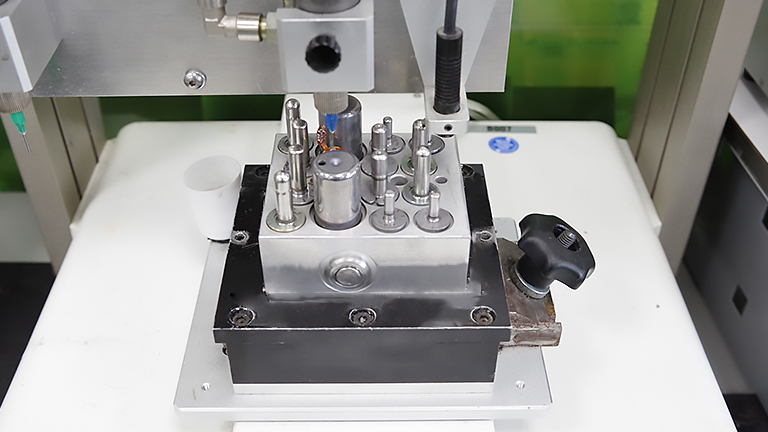ATE MK60
Audi, BMW, Citroen, Ford, Honda, Mini, Opel, Peugeot… Almost everywhere you encounter the ATE MK60. ABS has been mandatory for a while on new cars and because only Bosch and ATE have managed to tie in the major car manufacturers, you will only really find anti-lock braking systems of these two brands.
The system began in 1978 and simple, but in the meanwhile there have been some changes.The term “ESP” will now also sound familiar to many people. By using extra sensors in the car, a modern ABS system can also help a vehicle not losing traction in a bend. The values of the so-called yaw angle sensor (rotation rate sensor on the image) are compared to the extent to which the steering wheel (steering angle sensor) is turned. This allows the ABS ECU to determine whether one of the wheels must be braked to maintain the traction. Also, the ATE MK 60 ESP’s are available with this function.
What goes defective in many cases
With the ATE MK 60 we see an above average amount of problems that are related to the pressure sensor. The internet is full of complaints from customers who have the pressure sensor error showing, and therefore must have the complete unit replaced. The pressure sensor itself is often the cause of these symptoms. To provide an idea of what error codes could relate to
a faulty pressure sensor, we have compiled a list:
- Audi, Seat, Skoda, Volkswagen: 01435, 059B
- BMW: 5DF5, 5E20, 24096, 24100
- Citroën: P1301, P1302
- Daihatsu: C1246
- Ford: C1288
- Mazda: 0130, C1288, C0044/28, 64
- Mitsubishi C121D, C1364
- Opel: C1028, C0131
- Peugeot: C1301, C1302
- Renault: DF088
- Suzuki: C1028
- Toyota: C1246, often in combination with C1223
- Volvo: P0130, P0134
But what are the exact malfunctions within this pressure sensor ?
As soon as the pressure sensor has been carefully dismantled, the connection wires are barely visible to the naked eye, they really are microscopically small. Due to temperature changes and vibrations it can occur that these fragile wires eventually break. The repair of these defects is only possible with high-tech equipment
The remanufacture process
Before we start the remanufacture of the pressure sensor, we will first have to remove ECU and the pump motor from the hydraulic block.. The pressure sensor is otherwise not accessible, as it is positioned centrally on the HCU. Once disassembled, it is followed by a delicate process in which we disassemble the pressure sensor, open it, recondition the microscopic connections, replace the pressure sensor, and then extensive testing.
All high-tech equipment is customized in-house and programmed for this specific purpose. To further protect the new connections, we apply a special gel that protects against both vibrations and temperature differences. Due to this extra step, the remanufactured pressure sensor is more reliable than the original. We at ACtronics are very proud that this wat we can offer a quality remanufacture.

The ATE MK 60 in detail
The MK 60 roughly consists of three parts: the pump motor, the HCU and ECU. Together, they provide the operation of the system and these parts cannot really function without the other. We will explain the working of each part and explain in this way the ABS system as a whole.

The pump motor
The pump motor does nothing but maintain pressure on the entire brake system. ABS is a system that controls the flow in one or more calipers, momentary releasing brake pressure so that the brake caliper releases from the disc temporarily. Moments later the pressure is rebuilt, then it stops the flow and the pump motor builds back up the pressure in the system.
This process is repeated dozens of times per second when one or more wheels lose traction. This also creates the distinctive vibrating sensation in the brake pedal when the ABS system comes into action.
The HCU
The letters stand for Hydraulic Control Unit. The HCU looks like a large solid aluminum block in which all kinds of channels and actuators are hidden, it is these channels and actuators that make the ABS work in a correct way. The actuators in this block can open the channels momentarily to release pressure within the brake calipers. Fortunately, these channels at rest are always closed. You do not have to worry that the braking system stops functioning and if a failure occurs: the system is “foolproof” and if a fault occurs the car will just feel like an old-fashioned car without ABS: the brakes will still work.
When we zoom in further on the working of this HCU, the 12 “pins” stand out the most It is these actuator pins that can open and close the channels. The coils that sit at the bottom of the ECU, fit over these pins during assembly and once the ECU is put back under pressure, the pin is pushed down by a strong magnetic field. If this pressure drops the pin springs back up and the associated channel is closed immediately.
In between the actuator pins, we can also find the pressure sensor. This sensor continuously measures the fluid pressure in the system, and is very important for the pump motor. Because the pump motor is not running continuously, but jumps in at times when the pressure is too low. Without a well-functioning sensor, the fluid flow within the system cannot hold its pressure and as a precaution will cut out.
The ECU
Finally the ECU is the brain of the unit. Inputs from several sensors come in, including that of the wheel sensors and the just mentioned pressure sensor. Depending on the value, the ECU decides what action is needed and sends the information to the necessary actuators. The ECU then controls the HCU and the pump motor. As has just been mentioned, the ECU has coils on the bottom. To put pressure on these coils, the ECU can cause the pins to be pressed down and allow the fluid to flow.
In the case of ESP, the ECU has to do more. Inputs of the steering angle sensor and yaw angle sensor must be compared with each other to determine whether or not the vehicle makes a realistic angle of rotation. If the car turns more or less than expected by the value of the steering angle, then this causes either understeer or oversteer. ESP can correct both situations, by braking one or more wheels slightly different in order to obtain the desired angle of rotation (yaw angle) again. The ABS system then brakes completely independently one or more wheels without the brake pedal being applied. This is possible because the pump motor can put the system under pressure without the pedal being applied.
Disassembly of the ABS unit
Before starting the disassembly, we recommend that you disconnect the battery and connect it again only when the ABS assembly is mounted back. It is also known that there are cars where the ABS system must be re-initialized, keep this in mind when re-assembling. After disconnecting the connector first drain the brake fluid and then start the actual dismantling. The dismantling itself can vary greatly by type of vehicle. Refer therefore to the documentation available from the car maker. However, we stress that the hydraulic block is made from aluminum, this is a relatively soft material, so be careful when loosening and tightening the brake lines.

 da
da de
de es
es fr
fr it
it nb
nb nl
nl pt
pt sv
sv fi
fi